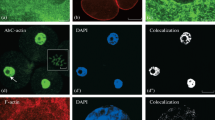Abstract
Using a cytoplasmic actin cDNA probe we have localized a number of actin sequences in the human genome using a novel in situ hybridization technique. Metaphase chromosomes treated to produce R-bands were directly annealed with 125I-labeled actin probe. Under these conditions many regions of the genome were apparently denatured enough to be capable of hybridizing with the probe. Most of the actin sites detected in prior experiments using chromosome preparations, which had been completely denatured, were recognized in this experiment. The major advantage of this method over standard in situ hybridization techniques is the marked increase in the resolution of subregional localization.
Similar content being viewed by others
References
Bernheim A, Berger R (1981) A simple method for improving the reproducibility of the R-banding technique. Hum Genet 57:432–433
Chandler ME, Yunis JJ (1978) A high-resolution in situ hybridization technique for the direct visualization of labeled G-banded early metaphase and prophase chromosomes. Cytogenet Cell Genet 22:352–356
Dodemont HJ, Soriano P, Quax WJ, Ramaekers F, Lenstra JA, Froenen MAM, Bernardi G, Bloemendal H (1982) The genes coding for the cytoskeletal proteins actin and vimentin in warmblooded vertebrates. The EMBO Journal 1:167–171
Dutrillaux B (1975) Sur la nature et l'origine des chromosomes humains. Expansion Scientifique Paris
Engel JN, Gunning PW, Kedes L (1981) Isolation and characterization of human actin genes. Proc Natl Acad Sci 78:4674–4678
Evans HJ, Buckland RA, Pardue ML (1974) Location of the genes coding for 18S and 28S ribosomal RNA in the human genome. Chromosoma 48:405–426
Firtel RA (1981) Multigene families encoding actin and tubulin. Cell 24:6–7
Gerhard DS, Kawasaki ES, Bancroft FC, Szabo P (1981) Localization of a unique gene by direct hybridization in situ. Proc Natl Acad Sci 78:3755–3759
Hanauer A, Heilig R, Devin M, Maisan JP, Grzeschik KH, Mandel JL (1983) The actin gene family in man: assignment of the gene for skeletal muscle alpha-actin to chromosome 1, and presence of actin sequences on chromosomes 2 and 3, and on the X and Y chromosomes (Abstract). International Human Gene Mapping Workshop VII, Los Angeles
Harper ME, Ullrich A, Saunders SF (1981) Localization of the human insulin gene to the distal end of the short arm of chromosome 11. Proc Natl Acad Sci 78:4458–4460
Humphries SE, Whittall R, Minty A, Buckingham M, Williamson R (1981) There are approximately 20 actin genes in the human genome. Nucleic Acids 9:4895–4908
ISCN (1978) An international system for human cytogenetic nomenclature (1978). Birth defects original article series, XIV, no 8. The National Foundation New York
Khalili K, Salas C, Weinmann R (1983) Isolation and characterization of human actin genes cloned in phage lambda vectors. Gene 21:9–17
Kirsch IR, Morton CC, Nakahara K, Leder P (1982) Human Ig heavy chain genes map to a region of translocations in malignant B-lymphocytes. Science 216:301–303
Lawrie S, Gosden J (1980) The identification of human chromosomes by quinacrine fluorescence after hybridization in situ. Hum Genet 53:371–373
Malcolm S, Barton P, Murphy C, Ferguson-Smith MA (1981) Chromosomal localization of a single copy gene by in situ hybridization-human β-globin genes on the short arm of chromosome 11. Ann Hum Genet 45:135–141
Opitz J, Pallister PD (1973) An (X; 14) translocation, unbalanced 47 chromosomes. Repository identification No GM74. Cytogenet Cell Genet 12:291–292
Robins DM, Ripley S, Henderson AL, Axel R (1981) Transforming DNA integrates into the host chromosomes. Cell 23:29–39
Soriano P, Szabo P, Bernardi G (1982) The scattered distribution of actin genes in the mouse and human genomes. The EMBO Journal 1:579–583
Steffensen DM, Wimber DE (1971) Localization of tRNA genes in the salivary chromosomes of Drosophila by RNA: DNA hybridization. Genetics 69:163–178
Yunis JJ (1976) High resolution of human chromosomes. Science 191:1268–1270
Yunis JJ, Roldan L, Yasmineh WG, Lee JC (1971) Staining of satellite DNA in metaphase chromosomes. Nature 231:532–533
Author information
Authors and Affiliations
Rights and permissions
About this article
Cite this article
Bernheim, A., Berger, R. & Szabo, P. Localization of actin-related sequences by in situ hybridization to R-banded human chromosomes. Chromosoma 89, 163–167 (1984). https://doi.org/10.1007/BF00292900
Received:
Revised:
Issue Date:
DOI: https://doi.org/10.1007/BF00292900




